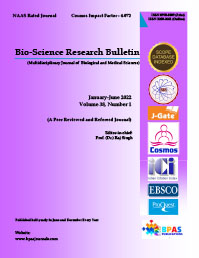Forensically Important and Seasonal Changes in Temperatures of Developmental Stages in Life Cycle of Sarcophagidae Fly, Sarcophaga Africa
DOI:
https://doi.org/10.48165/bpas.2023.39.2.2Keywords:
Forensic Insect, PMI season, Lifecycle Duration, Temp ChangeAbstract
Sarcophaga Africa is one of the hairy maggot flesh flies that feeds on meat carrion, and dead and decaying matter of animals to complete its life cycle which is useful for post-mortem interval (PMI). Determination in forensic investigations. The actual life cycle hours and days are calculated due to the morphological parameter of the life cycle of Sarcophaga Africa were studied in different seasons; The Life cycle in the rainy season was completed in 270 ± 1.25 hrs (11.25 ± 0.40 days), when the maximum temperature was 27.02°C and the minimum temperature was 26.4°C; in summer season when the maximum temperature was 36.6°C and the minimum temperature 33.2°C, the life cycle was completed in 220± 1.17 hrs (6.16. ± 0.10 days), while in cycle was completed in 310 ± 1.35hrs (12.91 ± 0.21 days) when the maximum and minimum winter season life cm temperatures were 27.4°C and 17.2°C respectively. The temperature plays an important role in determining the developmental stages of the life cycle of Sarcophaga Africa which should be considered during PMI determination. The external parameters of different stages differ from season to season. Larvae were healthy and bigger in the rainy season but in summer were short and small-sized. The size of larvae in the winter season was also smaller than the size in both summer and rainy seasons.
References
Abd Algalil, F.M. and Zambare S.P. (2015). Effects of Temperature on the Development of sarcophagid fly of forensic importance Oxysarcodexia terminalis. Indian Journal of Applied Research, 5, 767- 79.
Campobasso C.P., Di Vella G. and Introna, F. (2001). Factors affecting decomposition and Diptera colonization. Forensic Sci. Int. 120, 18-28.
Gennard D. (2007). Forensic Entomology. An Introduction. John Wiley, Sons Ltd, England. 2007.
Gomes, L., Augusto, W., Godoy, C., and Zuben, C.V. (2003). A review of post-feeding larval dispersal in flesh flies: implications for forensic entomology. Natur Wissen schaften. 93, 207-225.
Grassberger, M. and Reiter, C. (2002). Effect of temperature on the development of the forensically important holarctic blow fly Protophormia terraenovae (Robineau
Desvoidy) (Diptera: sarcophagidae). Forensic Science International. 128, 178-182.
Nafte, M. (2000): Flesh and Bone: An Introduction to Forensic Anthropology. Durham, NC: Carolina Academic Press Queiroz, M.M.C.
Smith KG. (1986). A Manual of Forensic Entomology. Trustees of the British Museum (natural history). London. 1986.
Smith, K.G.V. (1986): A manual of forensic entomology, London, UK: Cornell University Press.
Sukontason, K., Methanitikorn, R., Sukontason, K.L., Piangjai, S. and Olson, J.K. (2003). Clearing technique to examine the cephalopharygeal skeletons of flesh fly larvae. J. Vector Ecol. 29, 192-195.
Warren, J.A. and Anderson, G.S. (2013). Effect of Fluctuating Temperatures on the Development of a Forensically Important Blow Fly, Protophormia terraenovae (Diptera: sarcophagidae). Environmental Entomology. 42, 167- 182.
Wells JD, Stevens JR. (2010). Molecular methods for Forensic Entomology. In: Forensic entomology: the utility of arthropods in legal investigations 2nd edition (JH Byrd JH, Castner JL, eds.) CRC Press, Boca Raton. 2010, 437-452.
